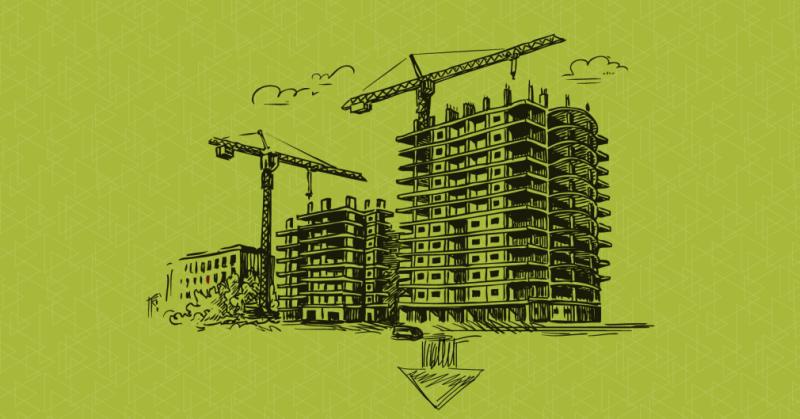Regulatory amendments, changing market dynamics & delayed approvals for development have largely resulted in stressed residential projects. The primary outcome of this has been a liquidity crunch in the sector, which is the major issue faced by the residential development sector currently.
Regulatory amendments, changing market dynamics & delayed approvals for development have largely resulted in stressed residential projects. The primary outcome of this has been a liquidity crunch in the sector, which is the major issue faced by the residential development sector currently.
Highlights
- Two major challenges real estate developers with residential portfolios face today: liquidity crunch and (related) decreased demand for residential asset class
- 4 regulatory developments which are a combination of sector-specific legislations and macroeconomic announcements have had a negative impact on the residential sector
- Additionally, adverse developments in the financial sector have compounded the challenge
- A major change has been witnessed in consumer behaviour with regard to rental housing has led to decreased demand for primary sales
Regulatory Developments of Note
Some of the regulatory amendments that negatively impacted the residential sector include:
- Implementation of Real Estate (Regulation and Development) Act (RERA) led to a shift in buyer preference for completed projects / those nearing completion as against investing in projects at launch / pre-launch stages
- Demonetization of currency notes resulted in overall reduction in absorption of residential projects
- Exemption on tax benefits for second homes has dampened the sales of premium residential units (ticket size over INR 1.5 Cr)
- Non-availability of GST input credit has led to increase in construction cost by 5% - 7%. Also, GST payable on land-owner's share has led to increase in unsold inventory
Other Major Impact Sources
- Defaults by two Non-Banking Financial Companies (NBFCs) - Infrastructure Leasing & Financial Services Limited and Dewan Housing Finance Corporation Limited – have further contributed to the liquidity crunch across the sector. Currently, investors and NBFCs have restricted their investments in the RE sector
- Emergence of rental housing has deferred the buying preference for residential real estate by the young population
- Unsold inventory across 7 cities in India is estimated at upwards of 400,000 units; primary reasons being - non-availability of necessary development approvals, liquidity crunch and sales not being up to the projected mark
- Working capital and operating cashflows of property developers today are under significant stress, which has resulted in slow progress or stalling of projects and lack of interest servicing ability (leading to NPA accounts)
Developers evaluating various options for dealing with stressed assets
Partnerships (JV and DM models), sale of commercial assets & land, and loan takeover by ARC funds are some of the options being evaluated by stressed developers.
Details of options being evaluated by stressed asset owners
Partnership:
- Joint Venture:
- Stressed developers holding land parcels are evaluating Joint Venture (JV) partnerships with established developers. The smaller developer ensures availability of clear-titled land along with development approvals &the larger developer offers brand advantage
- These partnerships usually work in case of lands that are strategically located and have development potential within a 1–3 years timeframe
- Development Management (DM):
- Projects with low sales volume since past three years are being taken up on the DM Agreement model by prominent / larger developers. DM is evaluated in cases where the project has necessary development approvals, established a threshold sales velocity and is not over-leveraged
Sale of Office Space and/or Land:
- Developers with commercial real estate and land parcels are evaluating asset sales to private equity funds / corporates / family offices / HNIs & UHNIs
Lending by ARCs & funds focusing on stressed assets:
- NPA1 NPA accounts today are being evaluated by ARCs and stressed funds. Stressed funds infuse additional funds in the project and may or may not provide an exit to the current lender
- Stressed funds usually evaluate project based on the location – proximity to economic hubs, connectivity and status of social infrastructure
- Net worth positive2, construction status of the project, ease of exiting existing lenders, customer settlements and revenue receivables are critically evaluated to understand financial viability of the project
- Exit from these projects is largely targeted through sales and IRR is pegged at between 20% - 23% depending upon the stage of project
Effort by the government and emergence of distressed funds
- The government’s Alternate Investment Fund (AIF) worth ₹25,000 Crore, aiming to offer last-mile funding to stuck housing projects, will be investing in them through non-convertible debentures (NCDs), and aims to generate 15-17% returns
- Stalled housing projects which would be eligible for the scheme are expected to:
- be in the affordable and mid-income segments;
- have a positive net worth 2;
- be at a stage where minimum 30% of the cost is to be incurred
- have an investment size not exceeding INR 400 Crore per project
- have existing lenders who will stay invested until completion of the project
- not use funds for refinancing of loans
- Apart from the efforts of the Government of India, other fund houses raising funds or evaluating stressed assets include:
- Kotak Investment Advisors Ltd, the alternative asset management arm of Kotak Group, which has hit the final close of its special situations fund at $1 Billion. The fund, launched in February 2019, is anchored by a $500 Million commitment from a wholly owned subsidiary of sovereign wealth fund, Abu Dhabi Investment Authority. The fund has a life of eight years with an investment timeline of four years, and will target to invest nearly Rs 350 - 500Crore in each deal. It is a sector-agnostic fund and will look to deploy capital across categories including steel and infrastructure among others, where the stress is higher. The fund is targeting returns of early 20% on pre-tax basis.
- Edelweiss Financial Services had raised $1.3 Billion through its Edelweiss India Special Assets Fund (EISAF) II, an alternative investment fund including insurance companies, pension funds and high net worth individuals. The mandate of EISAF II is centered around making value investments in stressed assets and viable non-performing assets. It is focused on assets with established infrastructure, viable business models and potential of generating cash flows.
- In addition, funds from South-East Asia, Middle East and Japan are evaluating investments in stressed assets
What Lies Ahead
- Years 2016 to 2019 have impacted all stakeholders of residential asset class significantly and a lot of caution is expected to be exercised going forward by these stakeholders
- Comprehensive due-diligence of project location, product size & specifications and pricing strategy will be done prior to project launches
- In my opinion, it is likely to take a minimum of 2 years for the asset class to gain normalcy
- What to expect in coming two years:
- Restricted or no pre-approval funding by NBFIs
- Developer profile will be a critical parameter and funding will be evaluated per project basis as against for multiple projects
- Merger & acquisitions likely to continue – JD / JV deals
- Launches will be restricted in the coming one-year horizon; by early 2021 the overhang likely to be in the range of 10 – 12 months
- Land prices likely to grow moderately
1Non-performing Assets Interest and / or installment of principal remain overdue for a period of more than 90 days in respect of a Term Loan
2Projects where value of receivables plus value of unsold inventory is greater than completion cost and outstanding liabilities at project level
About the Author
![Dhara Shah]()
Dhara Shah
Dhara has over 17 years of experience in Real Estate Investment and Consultancy. She has executed deals worth USD 10 million and led the team on executing 100 valuation assignments in the last 3 years. Prior to joining Meraqi she has worked with Vestian, UGL Equis and BPCL. Dhara is B.E (Civil) from S.V.NIT, Surat M.Tech (Infrastructure Planning) from CEPT, Ahmedabad.

